by Editor | Jan 14, 2008 | Accomodations, Ecotourism, New Articles
Article and photos by Josette King

Chongwe River Camp where the Chongwe and Zambezi rivers meet
After an exciting visit to the South Luangwa National Park in the fall of 2006, I returned to Zambia last year. In the Luangwa Valley, particularly lush in 2007 after experiencing intense seasonal flooding in January and February, I especially enjoyed Nkwali, the flagship camp of Robin Pope Safaris.
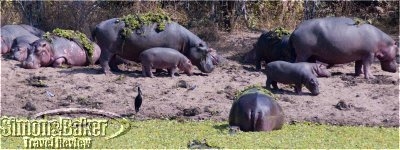
Hippos enjoyed the morning sun by their waterhole near Nkwali
Located on a prime vantage point on the east bank of the Luangwa River, Nkwali coupled the casual atmosphere and intimate proximity to wildlife that only a bush camp can provide with the indulgent amenities of the best safari lodges. From there, I traveled deep into the park to Luwi. This remote seasonal camp of reed and thatch huts offered a rare opportunity to experience one of the last traditional bush camps as envisioned by the renowned late conservationist and guide Norman Carr.

Cape buffalos throve in the Lower Zambezi National Park
I went on to explore the Lower Zambezi National Park. Established in 1983, it is the most recent of country’s national parks. Although still relatively underdeveloped, this stretch of wilderness is wedged between the Zambezi River and the Zambezi Escarpment; a privileged location that offers remarkably picturesque scenery and an amazing concentration of wildlife along its 120 kilometers of river frontage.
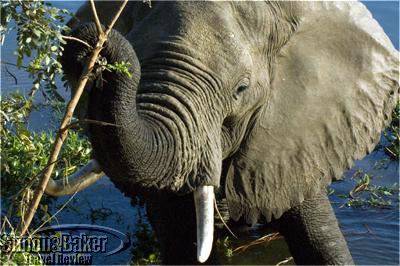
An elephant emerged from the Zambezi at Sausage Tree Camp
The river bank is home to several highly reputed wilderness camps and lodges, including the Chongwe River Camp, with its panoramic view of the confluence of the Chongwe River and the Zambezi rivers; the Chiawa Camp blended so unobtrusively into its surroundings that elephants and buffalos routinely paraded within feet of the tents on their way to the river; and the whimsical Sausage Tree Camp with its pristine conical Bedouin tents peering through the riverine forest canopy at the scenic entrance of the Chifungulu Channel.

A lioness
My journey concluded with a visit around Victoria Falls, where I experienced first-hand the award-winning accommodations and hospitality of Tongabezi, as well as the stunning architecture and sweeping vistas of the recently opened Stanley Safari Lodge.
Are you thinking of traveling to Zambia? Click on the following hyperlinks to read dedicated articles on Zambia destinations and properties visited by Simon & Baker travel teams Zambia, Lower Zambezi National Park, South Luangwa National Park, Chiawa Camp, Chongwe River Camp, Luwi, Nkwali, Sausage Tree Camp, Stanley Safari Lodge and Tongabezi.
by Editor | Nov 5, 2007 | Accomodations, Ecotourism, New Articles
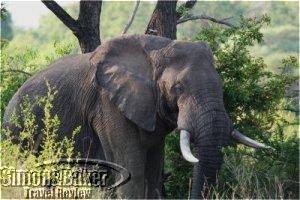
An elephant at Rattray’s*
Thanks to its location adjacent to the world famous http://simonandbaker.com/kruger in South Africa, the Mala Mala Reserve is ideally situated for Big Five game viewing. Perched on the edge of the larger Sabi Sand Reserve, Mala Mala shares a long fenceless border with the park through which prey and predator alike cross at will. This alone makes Mala Mala noteworthy because this area of Kruger is known for its outstanding game viewing.
Home of a popular lodge, Mala Mala Main Camp, the Reserve also houses the new and exclusive Rattray’s lodge. Where the Mala Mala Main Camp is a good buy for families and game viewing enthusiasts willing to share space with a few fellow travelers; Rattray’s is adult oriented and intimate.
During their stay at Mala Mala, our team appreciated the property’s Big Five orientation and friendly staff. The family owned Rattray’s lodge became a South Africa favorite. Small, intimate and structured to show off its animal guests, Rattray’s offered a fine safari experience. A young university trained game viewing guide doubled as a round the clock staff person assigned to each party of up to four guests for the duration of their stay.
The suites, each in a self contained building, were seductively elegant, comfortable and private. In addition to two full bathrooms, WiFi, and a laptop computer there was a private plunge pool. In the event a guest chose not to go on the early morning or sunset drive, the suite was a perfect place to lounge.
*Photo Elena del Valle

by Editor | Oct 22, 2007 | Ecotourism, Luxury Travel

The dock at Buddy Dive in Bonaire
Diving options and destinations abound across the globe. Warm water diving destinations are fewer but there are still many to choose from. Having sampled a few we favor Bonaire for several reasons: the island itself holds a charming appeal, friendly locals, lots of shore dive spots, numerous dive operators to choose from and nearby dive locations within a 15 to 30 minute boat ride. Other advantages include a southern Caribbean location away from the hurricane belt, an arid climate with limited rainfall, an on island recompression chamber in case of an accident, as well as protected and pristine tropical waters to showcase the best of the island’s underwater world.
Although the visibility was not 100 feet, as we read in many promotional websites and brochures before visiting the island, the water was clean and with minimum signs of human visitors. One of the reasons for the excellent condition of the marine environment is that all the area surrounding the island up to a depth of 200 feet has been a protected marine park for 25 years.
Locals care for their marine park and instruct visiting divers about the importance of protecting the environment. For example, first time visitors and those who have not been on the island in a year or longer are required to have an orientation with a local diver and pay for a marine park tag. We also noticed the dive staff we went out with were always protective of the coral reef and sea life when diving and reminded everyone on the dive boats to do the same.
For dive courses, relaxed diving, small groups, personalized attention, and resort shore diving we loved Great Adventures Dive & Water Sports Bonaire at Harbour Beach Village Club. On our last visit, we enjoyed many a shore dive including a brief sunset dive just off the beach. There were plenty of opportunities where we were one of a handful of guests on the dive boat. Several times we were the only two divers to go out. We enjoyed those especially because it was like chartering a private dive. Staff members were experienced and knew the area and dive sites well. They were helpful and friendly.
We also liked Buddy Dive at the Buddy Dive Resort. There was a constant buzz of activity, a healthy selection of dive options, courses and packages, and a well stocked dive shop. They catered to guests staying onsite, luxury property renters who only needed tank replacements and off site guests like us who needed an island orientation, were taking a course or fine tuning their diving skills. In spite of the many guests and staff, one of the characteristics we enjoyed most at Buddy Dive was the personal touch and service oriented staff.
by Editor | Oct 8, 2007 | Ecotourism, Luxury Travel
By Elena del Valle
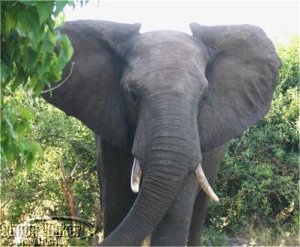
An elephant at the Chobe Safari Lodge
Visitors to Botswana are almost guaranteed an elephant sighting
For those thinking of going on safari in a remote area, this might be a good time to visit or revisit Botswana. The small and sparsely populated country is best known as the largest producer of gem quality diamonds in the world. The landlocked country, home to exclusive and remote safari camps and one of the largest herds of free roaming elephants in Africa, is making travel and tourism a priority.
Thanks in part to its mining wealth, this southern Africa country took the time and effort to develop its travel and tourism industry by planning ahead and focusing on luxury. Setting aside a large portion of its land for game viewing, the Botswana government issued concessions to private companies to establish temporary luxury oriented camps with minimum impact on the environment.
Although foreign companies and workers were allowed in initially, the government places strong emphasis on recruiting and training locals. The goal is for the luxury game viewing concessions to eventually be managed by Botswana natives. As part of the process, thousands of families were relocated from their ancestral homelands to make way for the game viewing reserves. At the same time, promising youth who grew up in farming and fishing families, were hired and placed on the fast track to training and promotion opportunities. This formula, though at times bumpy, seems to be paying off for Botswana.
The future of tourist travel in Botswana is bright according to the Tourism Satellite Accounting (TSA) report produced by the World Travel & Tourism Council (WTTC) and commissioned by the Government of Botswana and the Botswana Tourism Board. The report estimates the travel and tourism industry in Botswana will generate $1.6 billion in economic activity.
Over the next ten years Botswana’s travel and tourism industry is expected to achieve an annualized real growth of 5 percent, exceeding the world average at 4.3 per cent and the Sub-Saharan African average at 4.5 percent. According to the forecasts detailed in the report, travel and tourism already contributes over 10 percent of total employment and 16 percent of the non-mining gross domestic product of the country.
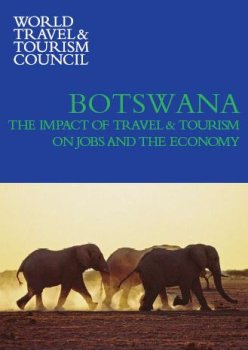
World Travel & Tourism Council report on Botswana
“Although this growth is positive and the country is one of the Africa’s most exciting travel destinations, it remains relatively unknown and is heavily dependent on intraregional tourists. Indeed, as far as long-haul markets are concerned, it is probably Africa’s best-kept secret,” said Jean-Claude Baumgarten, World Travel & Tourism Council. ”However these forecasts show that, with the right policy framework, Botswana has the potential not only to expand rapidly but also to significantly broaden its tourism product base, appealing to much a wider range of tourist tastes and budgets.”
Baumgarten believes the Botswana government has set many examples on how to run a country’s travel and tourism industry and preserve its environment, culture and heritage. Onkokame Kitso Mokaila, Botswana’s Minister of Environment, Wildlife and Tourism indicated that travel and tourism will be a priority for the country’s economy, which can no longer depend on its mining industry.
“This report comes at a crucial point for Botswana and will help the government to reach the highest level of potential that can be realized,” said Kitso Mokaila. “Travel and tourism will contribute enormously to the country’s economy and we are committed to running a conscious campaign to publicize the strategic role and benefits of tourism in order to stimulate a more positive perception to the wider public.”
The World Travel & Tourism Council is the forum for the chairs and chief executives of 100 prominent travel and tourism companies. The Council works with industry and governments to raise awareness of the strategic importance of travel and tourism, one of the world’s largest industries employing more than 230 million people and generating over 10 per cent of world GDP.
To find out about our travel teams experiences in Botswana click on the hyperlinks Botswana, Camp Okavango, Chobe Safari Lodge, Deception Valley Lodge, Kings Pool Camp, Kwara Camp, Kwetsani Camp, Lebala Camp, Nxai Pan Reserve/John Chase Safari, Savute Safari Lodge, and Xigera Camp.
by Editor | Sep 17, 2007 | Ecotourism, New Articles
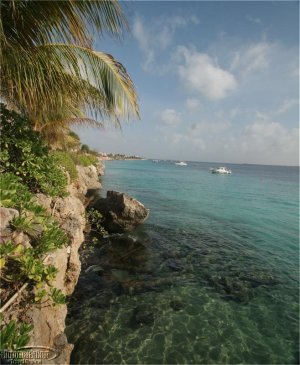
Bonaire is surrounded by a protected marine park
Two of our travel team members visited Bonaire, part of the Dutch Antilles, earlier this year. Following their visit, we published articles on the island (read part of the article below); Crown Court 44A, a waterfront luxury rental villa with high speed Internet access; Harbour Beach Village Club, the island’s premier resort; and two of the top dive operators, Great Adventures Dive & Water Sports Bonaire at Harbour Beach Village Club and Buddy Dive at the Buddy Dive Resort.
Bonaire
For a small island Bonaire really packs a punch. When few spoke about ecotourism in the Caribbean, Bonaire was busy establishing marine and national parks. Island authorities still oversee those areas with care, ensuring unspoiled waters for locals and visitors alike. At the same time, although for years it has been a diving Mecca attracting countless European and United States visitors, locals have not rested on their laurels. We observed pleasant, well organized, modern operations staffed by enthusiastic divers with a professional attitude.
by Editor | Sep 10, 2007 | Accomodations, Ecotourism, New Articles
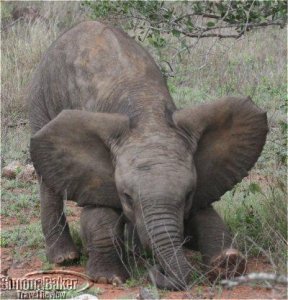
Ivory Lodge, a family built owned and managed lodge on the banks of the Sabie River, offered first class Big Five game viewing, luxury accommodations, appetizing meals and the kind of personal service only a small property can provide. Among its many distinctions was fronting the Sabie River for which the Sabi Sand Reserve was named. It offered eco-friendly game viewing following strict policies to protect the land. The Lion Sands Reserve on which the property was located, employed a full-time ecologist to manage and oversee the care of the land. Click here to read about Ivory Lodge at Lion Sands





















